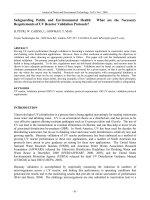What are the three types of rocks
Bạn đang xem bản rút gọn của tài liệu. Xem và tải ngay bản đầy đủ của tài liệu tại đây (505.42 KB, 24 trang )
Aim: What are the three types of rocks?
I. Rocks – made up of more than one mineral. Rocks are
classified according to how they were formed. Igneous,
sedimentary, and metamorphic are the three main groups of
rocks.
A. Igneous Rocks– rocks that form from hot
magma (molten rock) when it cools and solidifies.
1. Lava – magma that has reached earth’s
surface.
2. Rate of cooling can be determined by crystal size.
a. Intrusive igneous rocks - have large crystals due to
the slow cooling of magma inside the earth.
b. Extrusive Igneous Rocks – have small crystals
due to the fast cooling of lava on the earth’s
surface.
3. Igneous rocks are classified according to crystal
size and color.
GO TO PAGE 6 OF YOUR ESRT’S
a. Felsic igneous rocks – light in color, low in
density, and rich in feldspar and silica.
b. Mafic igneous rocks – dark in color, high in
density, and rich in magnesium and iron.
Granite – coarse texture
Rhyolite – Fine texture
Andesite – Fine texture
Obsidian – Glassy Texture
B. Sedimentary Rocks – rocks that are formed by the
hardening and cementing of layers of sediments.
1. Three types of Sedimentary Rocks
a. Clastic – rocks formed from fragments of
other rocks. Ex: shale, sandstone, conglomerate.
b. Chemical (Chrystaline) – rocks formed from
mineral grains that fall out of a solution
(precipitate) by evaporation or chemical reaction.
Ex: rock salt and limestone.
c. Organic – rocks formed from the remains of plants
and animals. Ex: coal and limestone made of shell
fragments
2. Characteristics of Sedimentary Rocks
a. Have layers (stratification)
b. Contain fossils (remains, impressions, or any other
evidence of plants and animals preserved in rock.
Conglomerate rocks are sedimentary rocks. They are
made up of large sediments like sand and pebbles. The
sediment is so large that pressure alone cannot hold the
rock together; it is also cemented together with dissolved
minerals.
Sandstone rocks are sedimentary rocks made from
small grains of the minerals quartz and feldspar. They often
form in layers as seen in this picture. They are often used
as building stones.
Shale rock is a type of sedimentary rock formed from clay
that is compacted together by pressure. They are used to
make bricks and other material that is fired in a kiln.
Limestone rocks are sedimentary rocks that are made
from the mineral calcite which came from the beds of
evaporated seas and lakes and from sea animal shells.
This rock is used in concrete and is an excellent building
stone for humid regions.
Gypsum rocks are sedimentary rocks made up of
sulfate mineral and formed as the result of evaporating
sea water in massive prehistoric basins. It is very soft
and is used to make Plaster of Paris, casts, molds, and
wallboards.
3. Metamorphic Rocks – rocks that have been
exposed to great heat and pressure.
a. Dynamic (Regional) Metamorphism – large areas
of rock under great heat and pressure. (mountain
building)
b. How heat and pressure causes rocks to change:
•Pressure squeezes grains closer together causing
the rocks to become more dense and less porous.
•Rearrange particles (atoms). Minerals are
reformed or new ones are created.
c. Thermal (Contact) Metamorphism – igneous
intrusions bake overlying rock. The changes in the
rock are less drastic than regional metamorphism and
foliation is not produced.
d. Characteristics of Metamorphic Rocks:
•Foliation – grains are in parallel layers. Ex: slate
•Banding – bands of light colored minerals
alternate with bands of dark colored minerals.
Gneiss is a high grade metamorphic rock. This means that gneiss has
been subjected to more heat and pressure than schist. Gneiss is coarser
than schist and has distinct banding. This banding has alternating layers
that are composed of different minerals. The minerals that compose
gneiss are the same as granite. Feldspar is the most important mineral
that makes up gneiss along with mica and quartz. Gneiss can be formed
from a sedimentary rock such as sandstone or shale, or it can be formed
from the metamorphism of the igneouse rock grantite. Gneiss can be
used by man as paving and building stone.
Quartzite is composed of sandstone that has been metamorphosed.
Quartzite is much harder than the parent rock, sandstone. It forms from
sandstone that has come into contact with deeply buried magmas.
Quartzite looks similar to its parent rock. The best way to tell quartzite
from sandstone is to break the rocks. Sandstone will shatter into many
individual grains of sand while quartzite will break across the grains.
Slate is a fine-grained metamorphic rock with perfect cleavage that
allows it to split into thin sheets. Slate usually has a light to dark brown
streak. Slate is produced by low grade metamorphism, which is caused
by relatively low temperatures and pressures.
Slate has been used by man in a variety of ways over the years. One use
for slate was in the making of headstones or grave markers. Slate is not
very hard and can be engraved easily. The problem with slate though is
its perfect cleavage. The slate headstones would crack and split along
these cleavage planes. This is not a desirable attribute for a head stone.
Slate was also used for chalk boards. The black color was good as a
background and the rock cleaned easily with water. Today it is not very
advantageous to use this rock because of its weight and the splitting and
cracking over time.
Schist is a medium grade metamorphic rock. This means that it has been
subjected to more heat and pressure than slate, which is a low grade
metamorphic rock. As you can see in the photo above schist is a more
coarse grained rock. The individual grains of minerals can be seen by the
naked eye. Many of the original minerals have been altered into flakes.
Because it has been squeezed harder than slate it is often found folded
and crumpled. Schists are usually named by the main mineral from
which they are formed. Bitotite mica schist, hornblende schist, garnet
mica schist, and talc schist are some examples of this.
Marble is metamorphosed limestone or dolomite. Both limestone and
dolomite have a large concentration of calcium carbonate (CaCO3).
Marble has many different sizes of crystals. Marble has many color
variances due to the impurities present at formation. Some of the
different colors of marble are white, red, black, mottled and banded,
gray, pink, and green.
Marble is much harder than its parent rock. This allows it to take a polish
which makes it a good material for use as a building material, making
sink tops, bathtubs, and a carving stone for artists. Today, headstones are
made from marble and granite because both of these rocks weather very
slowly and carve well with sharp edges.
Marble is quarried in Vermont, Tennessee, Missouri, Georgia, and
Alabama.









